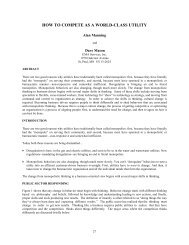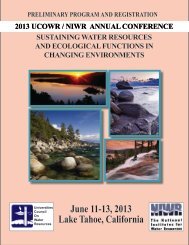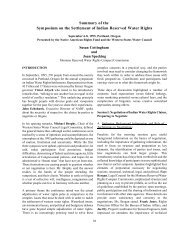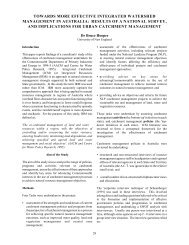104Lamoree <strong>and</strong> van Steenbergen<strong>and</strong> non-repair is common.3. In many irrigation systems, non-payment<strong>of</strong> dues or manipulation <strong>of</strong> bills throughunderassessment is a major factor. As long asthis is the case, any strategy centered on waterpricing is bound to be ineffective.4. In semi-humid areas, irrigation is a “back up”service in case rains fail; irrigation dem<strong>and</strong>as a result fluctuates from year to year. Inthese situations, dem<strong>and</strong> management throughpricing could undermine the financial viability<strong>of</strong> the irrigation operations.5. Most important, major gains in irrigationefficiency particularly in large systems, do notoccur necessarily at the farm level where thepricing argument would work, but at the mainsupply level.A telling example <strong>of</strong> the argument describedabove comes from the Krishna Delta in AndhraPradesh, South India. During the three-yeardrought, a more efficient scheduling <strong>of</strong> mainsystem irrigation supplies was introduced. This notonly prevented a drop in production levels, but infact even resulted in slightly increased crop yields.In the same drought period, irrigation supplies tothe irrigation canals in Sindh Province in Pakist<strong>and</strong>ecreased 20 percent, but again agriculturalproductivity remained at the same level. There wasa drastic reduction in water logging in the Province(from 2 million ha to less than 500,000 ha) <strong>and</strong> amove towards conjunctive use <strong>of</strong> shallow groundwater <strong>and</strong> surface water supplies.The main weakness in the economic goodsargument is that water has been seen as a“commodity” or “good” only in the sense thatcharges should be raised for providing it. In manyinstances, the cost recovery argument has donemore harm than good. It has tended to move theattention away from improving the quality <strong>of</strong>operations or rationalizing costs. The latter isnot a small issue. There are many examples <strong>of</strong>enormous financial wastages in the water sector.In the irrigation system in Punjab Province <strong>of</strong>Pakistan, for instance, energy charges for deepdrainage wells made up more than 50 percent <strong>of</strong>the expenditure, long after these deep wells losttheir functionality. In such situations the questionarises whether it makes sense to recover such costsfrom water consumers.The other harm comes from the exclusive focus inmany areas on the largest group <strong>of</strong> water consumers– farmers. In poor countries this is the most difficultgroup to tax, if only because <strong>of</strong> their sheer numbersin many countries <strong>and</strong> the relatively small amountsto be billed. Opportunities for charging otherwater users (e.g., industries, municipalities, leisureoperators) have <strong>of</strong>ten not been exploited. It shouldbe noted in this context that the absence <strong>of</strong> broadbasedorganizations focused on multiple values isan important shortcoming <strong>of</strong> governance systems.The final drawback <strong>of</strong> the paradigm is the focus onwater as a good to be allocated <strong>and</strong> paid for, turningaway attention from the many other values createdwith water that can be capitalized <strong>and</strong> collected.From an integrated development <strong>and</strong> managementpoint <strong>of</strong> view, water <strong>and</strong> water management shouldbe seen as an important ingredient in local areadevelopment <strong>and</strong> sustainable management; goodwater management services will improve thefunctions <strong>and</strong> values in the area.The “water as an economic good” paradigm,<strong>and</strong> in particular the commodification <strong>of</strong> wateras a tradable asset, are reductionist approachesto making water management manageable on thebasis <strong>of</strong> a measurable <strong>and</strong> quantifiable basis. Suchan approach is justifiable so long as it does notlead to the notion that water management can orshould be performed on the basis <strong>of</strong> the economicaspects <strong>of</strong> water only. <strong>Water</strong> has many aspects <strong>and</strong>hence many functions with different values, each<strong>of</strong> them important to a different set <strong>of</strong> legitimatestakeholders. All these values provide businessopportunities that should be capitalized upon<strong>and</strong> used to finance investment <strong>and</strong> operation. Inaddition, water management produces values thatare <strong>of</strong> a general public good nature, for instancegeneral flood protection or maintaining ecologicalbalances. Such values should be paid for fromgeneral taxes or public funding.The Institutional Way ForwardIntegrated <strong>Water</strong> Resource Management(IWRM) with its emphasis on optimizing manyfunctions, addressing different categories <strong>of</strong> values(economic, social, environmental), <strong>and</strong> setting up ameaningful engagement <strong>of</strong> different stakeholders isUCOWRJOURNAL OF CONTEMPORARY WATER RESEARCH & EDUCATION
Making IWRM Work105an eminently useful approach to water management.Capitalizing on these increased values, in our view,holds more promise for promoting <strong>and</strong> financingIWRM than the more limited water cost-recoverystrategies associated with the Dublin principle <strong>of</strong>water as an economic good.There are several institutional challengesin operationalizing this values <strong>and</strong> financesframework. A first challenge is how to quantifyvalues in a general framework. How should valuesbe compared <strong>and</strong> related to different functions?How should priorities be set? This problem couldeasily translate into a complex <strong>and</strong> irresolvablequestion, especially if simplistic reductionistmethods are to be avoided that translate all valuesinto one quantifiable parameter, thus violatingthe complexity <strong>of</strong> water values. The problem,however, may not be as large as it seems. First,awareness <strong>of</strong> the many functions in water resourcesystems <strong>and</strong> the quantification <strong>of</strong> each <strong>of</strong> themultitude <strong>of</strong> distinguishable values would be agreat leap forward in many situations. The defaultin many areas is that water is either not managedat all or only managed from a narrow perspective.Moreover, in many cases values are complementaryrather than competitive; this changes the problem<strong>of</strong> setting priorities. A pragmatic approach in mostcases seems appropriate <strong>and</strong> sufficient; that is,trying to make much out <strong>of</strong> the various functionsthat come along with improved water management<strong>and</strong> merely avoiding clear negative values.Involving stakeholders in the complex process canbe translated into win-win situations.In financing integrated water management, thestrategy should also not be to maximize returns <strong>and</strong>thereby focus on financially valuable functions suchas property development or leisure development.An example is the West Delta Project in Egypt.It is a valid question to ask whether one shouldhave used fossil ground water resources close to themajor city in the country to develop a golf course,even though in the short term this was a functionthat generated very high monetary values. Thechallenge for water resource managers — preferablyin an open consultative process — is to balance thedifferent functions, not necessarily to maximizefinancial returns. Once again, an institutional settingthat is tasked <strong>and</strong> equipped to balance <strong>and</strong> optimizemultiple functions, rather than maximize individualones, will be better able to h<strong>and</strong>le the finance captureapproach from a IWRM angle.Conclusions <strong>and</strong> DiscussionIn this paper, we have presented variousperspectives on the operationalization <strong>of</strong> IWRM.The first is that the international discourse hasfocused on governance issues in their institutional<strong>and</strong> legal context, while insufficiently addressingthe vital issue <strong>of</strong> financing IWRM.From the perspective <strong>of</strong> IWRM, water shouldbe managed through multiple functions <strong>and</strong>multiple stakeholder-oriented organizations suchas river basin organizations. These are also in abetter position to reach a balance in the capturing<strong>of</strong> values <strong>and</strong> their transformation into financialvalues. Whereas mono-sectoral water managementcan easily lead to the commodification <strong>of</strong> water ifconsidered an economic good only, multi-sectoral<strong>and</strong> multi-stakeholder institutions such as riverbasin organizations should normally be betterequipped to optimize functions <strong>and</strong> their relatedvalues.In the light <strong>of</strong> this, the challenge to capturevalues <strong>and</strong> to finance IWRM thus translates intoa challenge to create viable area-based watermanagement institutions that are explicitly tasked<strong>and</strong> equipped to achieve balance between functions<strong>and</strong> values. This transformation will become mucheasier as soon as the perspective shifts from theextra management tasks towards the extra revenuegeneration opportunities. To take a more businesslike approach to water management by quantifyingthe value <strong>of</strong> different functions would already be amajor step forward in most cases.As a contribution towards the discussion onhow to operationalize IWRM, we propose thatparticipatory business planning is a workablemethod to achieve a focus on the multiple valuesincorporated in the water system. Businessplanning, as a process for raising awareness <strong>of</strong> bothwater management institutions <strong>and</strong> stakeholdersalike, can have various positive effects. First <strong>of</strong> all,it has the potential to change a water managementinstitution’s focus from costs (to be met from alimited, mostly government-provided budget)towards a focus on revenue <strong>and</strong> income-generation.Second, it has the potential to engage stakeholdersin a discussion that focuses on multiple values <strong>and</strong>JOURNAL OF CONTEMPORARY WATER RESEARCH & EDUCATIONUCOWR
- Page 3:
Journal of ContemporaryWater Resear
- Page 6 and 7:
2Bruce Hooperinstitutional, and tem
- Page 11 and 12:
IWRM: Governance, Best Practice, an
- Page 13 and 14:
IWRM: Defi nitions and Conceptual M
- Page 15 and 16:
IWRM: Defi nitions and Conceptual M
- Page 17 and 18:
IWRM: Defi nitions and Conceptual M
- Page 19:
IWRM: Defi nitions and Conceptual M
- Page 22 and 23:
18Cardwell. Cole, Cartwright, and M
- Page 24 and 25:
20Mostert26 water boards responsibl
- Page 26 and 27:
22MostertTable 1. Third National Wa
- Page 28 and 29:
24MostertImplementationThe ambitiou
- Page 30 and 31:
26MostertBiswas, A. K. 2004b. Respo
- Page 32 and 33:
28UNIVERSITIES COUNCIL ON WATER RES
- Page 34 and 35:
30Ashton, Turton, and Rouxresource
- Page 36 and 37:
32Ashton, Turton, and Rouxassumptio
- Page 38 and 39:
34Ashton, Turton, and RouxEffective
- Page 40 and 41:
36UNIVERSITIES COUNCIL ON WATER RES
- Page 42 and 43:
38Hussey and Doversin water policy
- Page 44 and 45:
40Hussey and Dovers1994 Council of
- Page 46 and 47:
42Hussey and Doversestablished Thes
- Page 48 and 49:
44Hussey and DoversTable 1. Typolog
- Page 50 and 51:
46Hussey and Doversassessment appro
- Page 52 and 53:
48Hussey and Doverspolicy goals.Bey
- Page 54 and 55:
50Hussey and DoversFrawley, K. 1994
- Page 56 and 57:
52Mitchelloften took three to four
- Page 58 and 59: 54Mitchelltree preservation plans;
- Page 60 and 61: 56UNIVERSITIES COUNCIL ON WATER RES
- Page 62 and 63: 58Genskow and Borna series of chall
- Page 64 and 65: 60Genskow and BornTable 1. Watershe
- Page 66 and 67: 62Genskow and Bornthe first Dungene
- Page 68 and 69: 64Genskow and BornWashington, DC.Ko
- Page 70 and 71: 66Green and Fernández-BilbaoWithin
- Page 72 and 73: 68Green and Fernández-Bilbaosubjec
- Page 74 and 75: 70Green and Fernández-Bilbaoinflue
- Page 76 and 77: 72Green and Fernández-BilbaoBerbel
- Page 78 and 79: 74UNIVERSITIES COUNCIL ON WATER RES
- Page 80 and 81: 76BallweberEstablish AdvisoryCommit
- Page 82 and 83: 78Ballweberattributes in others (Ch
- Page 84 and 85: 80UNIVERSITIES COUNCIL ON WATER RES
- Page 86 and 87: 82Barreiraand ground water. To this
- Page 88 and 89: 84Barreirawith other states for int
- Page 90 and 91: 86UNIVERSITIES COUNCIL ON WATER RES
- Page 92 and 93: 88Davis and ThrelfallResource Manag
- Page 94 and 95: 90Davis and ThrelfallTable 2. Thirt
- Page 96 and 97: 92Davis and Threlfallby regional an
- Page 98 and 99: 94Davis and Threlfallenforcement, a
- Page 100 and 101: 96Davis and Threlfallhusbandry prac
- Page 102 and 103: 98Davis and ThrelfallNew Zealand: T
- Page 104 and 105: 100UNIVERSITIES COUNCIL ON WATER RE
- Page 106 and 107: 102Lamoree and van SteenbergenIt is
- Page 110 and 111: 106Lamoree and van Steenbergeninter
- Page 112 and 113: 108BourgetWorks Planner Capability
- Page 114 and 115: 110Bourgetwith over 600 people resp
- Page 116 and 117: 112Bourgetgovernment’s intrusion
- Page 118 and 119: 114Bourget4.management, drought man
- Page 120 and 121: 116McKayFigure 1. The four paradigm
- Page 122 and 123: 118McKay4. Paradigm 4 (which commen
- Page 124 and 125: 120McKaythree main functions:1. ass
- Page 126 and 127: 122McKayState Implementation of the
- Page 128 and 129: 124McKayTable 2. Corporate governan
- Page 130 and 131: 126McKayFigure 4. Qu. 26 - The ESD
- Page 132 and 133: 128McKayFigure 7. Qu.93- This organ
- Page 134 and 135: 130McKayBrundtland Report. 1987. Ou
- Page 136 and 137: 132UCOWR BOARD OF DIRECTORS/COMMITT
- Page 138 and 139: 134BENEFITS OF UCOWR MEMBERSHIPThe
- Page 140 and 141: 136Past Issues of the Journal of Co
- Page 142 and 143: 138Academic Organizations Membershi
- Page 144 and 145: 140Individual Membership Applicatio
- Page 146 and 147: Universities Council on Water Resou
- Page 148: Integrated Water Resources Manageme








